PART 11
Now let's go the other way, Africa's Western Diaspora. Now we look on Europe, in this case it's just simply a part of the western Diaspora of Africa, because African people went up into Europe too, and then went through the rest of the continent of Africa. They went to West Africa and they went to the Caribbean. They also went to South America all of which is being called Africa's Western Diaspora.
Now let's look at the European Diaspora which is what we need to be concerned with, and is referred to as the age of imitation. Europe at the point of its beginning in civilization starts out imitating African people. They start out first with Grimaldi , in other words, the first Europeans were Africans.
They start out with the origin of Greece as being African, in other words, Egyptians appeared to have settled in Greece and initiated the Greek civilization which is Europe's classical civilization, the Kemetic enlightenment of the Greco-Roman conquerors. In other words, when the Greeks later turned around and became the political power in Egypt, the Egyptians were the ones who enlightened Greece, rather than the other way around.
The Romans had a cultural revolution that started because of their contact with Egypt, then there was a war, the Europeans then turned on Africa to wipe out the whole African culture that had given birth to much of the European culture. Then when Europe goes into the dark ages it comes out of it in part, because Africans (Moors) came back into Europe and established universities in such places as Spain and Portugal.
So you may ask when was the Dark Age in Africa, well that is now. The dark ages have been around for the last 2000 years, because one conqueror or another has had major control of Africa be it Arabic conquerors, European conquerors or others. It has been difficult throughout the continent of Africa over the last 2000 years for Africans to be independent except in certain places like Mali, Songhai, Ghana and a few others that did flourish under tremendously difficult circumstances.
The Moors went to Europe in 711 AD where they crossed the straits of Gibraltar which was named after an African General Tarik al Gibral, and established dominance in Spain and Portugal before moving up into other places throughout Europe. The African Moors were expelled in 1492 after which there was the second European war on African culture.
It was indicated that the first Europeans were Africans. For this we go back to Dr. Cheikh Anta Diop's original explanation for the emergence of Homo sapiens sapiens in the Nile Valley about 130,000 years ago, or maybe as early as 150,000 years ago. But the first time Homo sapiens sapiens appeared in Europe, it looked like the figure on the left, which is a Grimaldi statue, and that is about 40,000 years BC.
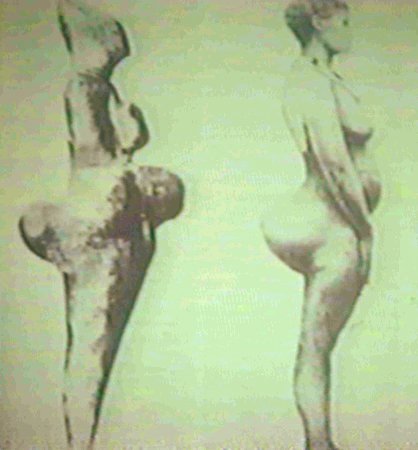 At that point, the European population is clearly an African population in physical type and in the bones that are dug up. The palaeontology's study of bones in Europe of Grimaldi shows them to be African type 40,000 years ago.
At that point, the European population is clearly an African population in physical type and in the bones that are dug up. The palaeontology's study of bones in Europe of Grimaldi shows them to be African type 40,000 years ago.
The Grimaldi statue on the left of the picture is being used in comparison to the Zulu woman on the right though a pigmy could have been used, but you would see that they have the same basic body type especially with the heavy deposits of fat in the rear, which is in technical terms called steatopygia. That body type is most pronounced in so-called pigmy populations and in Zulu populations, and here it is found in Grimaldi populations.
So if you take just the body type alone, you have an Africoid population as the earliest European population. That population then evolves into Cro-Magnon according to Professor Cheikh Anta Diop which is just a theory, but it is as good a theory as any other theory. This happens around 20 to 30,000 years ago because of the ice age, in other words, the adaptation of Grimaldi to the cold climate in Northern Europe in particular, is responsible for the physical change in the Africoid population so that it becomes what we now think of as the European population.
Is there a need for African-American children students to seek out the African historians for direction?
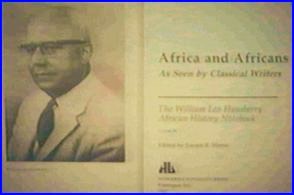 It is absolutely essential. Here, for example is an African-American historian, there had not been anyone other than Hansberry until recently who was interested in his topic. In other words, there are many non-African scholars who have the technical capability to do the historical research, but the questions that Africans and African-Americans identify as priority questions almost always are different questions.
It is absolutely essential. Here, for example is an African-American historian, there had not been anyone other than Hansberry until recently who was interested in his topic. In other words, there are many non-African scholars who have the technical capability to do the historical research, but the questions that Africans and African-Americans identify as priority questions almost always are different questions.
For example, his question is, "what did the Greeks and Romans say in the classical writings about Africa". No one else has done this except William Leo Hansberry, but in order to do it, he tried to get a degree in Harvard, but they wrote him a letter saying that no one knew as much about this topic as he did, so there is no one there who could give him an examination in order for him to get his doctorate, so he never got his doctorate.
This would be an example, the kinds of questions that Dr. Cheikh Anta Diop raises on the racial background of the Egyptians. Very few people have been interested in doing that kind of detailed and painstaking research, the kind of work that Professor Obenga, an African who does the linguistic origins of Egyptian civilization, performs. So time and time again, you will find that Africans or African-Americans or the African Diaspora have special questions as well as the historical expertise to enable them to present something fresh and new by way of interpretation on facets of history. So it is absolutely essential that African people go to those people who have the questions which they want answered as their primary focus of concern. It doesn't mean that white scholars can't do research on that area, in fact, many of the people who have done some of the best work on African origins and history have been some of the white scholars. So it is not a matter of the colour of the person, but more a matter of the priority and the confidence of that person.
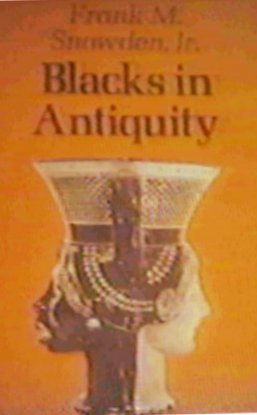 Just as indicated in the rules outlined before with regard to using source material wherever possible, Hansberry too was interested in original sources, so he went to the classical writers. In other words, he read in Greek and Latin what the ancients had to say about Africa.
Just as indicated in the rules outlined before with regard to using source material wherever possible, Hansberry too was interested in original sources, so he went to the classical writers. In other words, he read in Greek and Latin what the ancients had to say about Africa.
What they said was that they were overwhelmed with Africa. Africa appears as a beautiful, intellectual, high tech place to the Greeks and Romans, and they were not embarrassed about saying these things.
Later, historians would forget that. Frank Snowden, in his book called "Blacks in Antiquity", looked at some of the literary evidence and also at the archaeological data on the fact that Blacks were in Greece and Rome.
What is called the European and African Diaspora is done deliberately to emphasize the fact that we are now going to see major and not just a casual cultural impact on Europe from Africa. At the bedrock of European civilization is an African foundation and this is the part that will be demonstrated.
For example, as early as you can find any record in Europe, you will find a record of Africa, and the artefacts that you collect from the earliest times that you can collect in Greece, you will find Africans artefacts.
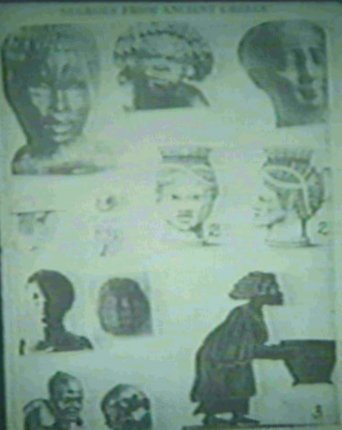 These artefacts won't be primarily about slaves although occasionally you will find that, but if they show Africans in books that are written about Greece or Rome, they are shown as slaves.
These artefacts won't be primarily about slaves although occasionally you will find that, but if they show Africans in books that are written about Greece or Rome, they are shown as slaves.
What is seen here comes from J A Roger's book. Copies or pictures of some of the almost royal and divinities that are African are seen in the centre at the top like the goddess Melinus in Greece who was an African goddess, or at the bottom in the lower right by the number 3, where you can see the mother of the oracle Adelphi. In other words, the whole concept of oracles comes out of Egypt into Greece.
 These are all artefacts that come from Greece. If you look at the lower left you will see the statue of Agamemnon.
These are all artefacts that come from Greece. If you look at the lower left you will see the statue of Agamemnon.
Remember in Greece you had this Ethiopian General Memnon who had Ethiopian troops when the Greeks were fighting at Troy in the Trojan War.
By the way, in none of the movies shown have they ever shown Black people as major figures in the Trojan War, and yet Ethiopians who were there had been led by this Ethiopian general in the Trojan War. The Greeks knew that he was there and that he even had an Africoid appearance.
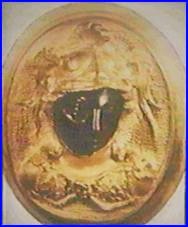 This is the Goddess Athena in Russia around 200 BC from which Athens in Greece is named, and this is the way they pictured her. Moreover, she was always shown as a Black goddess.
This is the Goddess Athena in Russia around 200 BC from which Athens in Greece is named, and this is the way they pictured her. Moreover, she was always shown as a Black goddess.
It was only recently after that early period that you begin to see other images of her not as a Black goddess but as a white goddess.
 This is a Greek manuscript from the period just before Christ or around the 5th century showing the Prophet Isaiah in the middle. Notice that he is shown as a Black man.
This is a Greek manuscript from the period just before Christ or around the 5th century showing the Prophet Isaiah in the middle. Notice that he is shown as a Black man.
You see an Ethiopian priest on the right with his little rattle or sistrum, and you see a Greek woman on the left.
In other words, these are images that the Greeks drew in their time showing a distinction between the Greek woman on the left, and Isaiah and the Ethiopian priest who are shown as the same racial type.
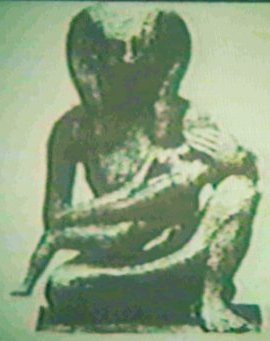
This is the way that Africans showed Isis and Horus. You see her as the Black Madonna and Child. What you have to know is that this image had a profound impact on the European conquerors, on the Greeks and Romans in particular, and later on in Europe itself. This religion was in place at the time that the Christian church was founded.
This was before the birth of Christ when the Greeks and Romans became worshippers of Isis. They had temples to Isis all over Greece and Rome, they had temples all over Persia, they had temples to Isis in Paris and so forth. She was a very powerful figure and so they were devoted to the Madonna and Child and she was a Black Madonna and Child as shown here.
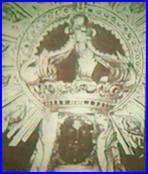 Now let's look at what happens to Isis after the Christian church gets founded. Remember you don't have a formal Christian church until a king Constantine establishes a Christian church, and he wasn't even a member at the time.
Now let's look at what happens to Isis after the Christian church gets founded. Remember you don't have a formal Christian church until a king Constantine establishes a Christian church, and he wasn't even a member at the time.
He convened a council of bishops and he had political reasons for wanting a national church, because the people in his land were worshiping a goddess Isis and that meant that they were under the theological control of an African priesthood, because the priests of Isis were in Egypt, the ones that had the authority.
It would be like the Catholic Church having its headquarters in Rome, so the ultimate authority for the Catholic church would be in Rome. Constantine had a political problem, he had political unity but not religious unity, so to bring that all into one place, he establishes the Christian church which was initiated at the Council of Nicea.
It's interesting that in the first four hundred years of the Christian church, they didn't have any big problem about the virgin. Mary just didn't figure into it. The people were still worshipping in this competing religion with Isis and the religion associated with her. So you see in this picture then, one of the early Black Madonnas that appear, showing that when Mary is finally adopted by the Christian church, almost all of the original Mary's were Black like this one.
Here is another example of a Black Mary, the Virgin of Kazan, whom you see as the Black Madonna and Child in the first two images. As another example, the Polish Pope when he returns to Poland goes to visit the Holiest Shrine in Poland which is the shrine of The Virgin of Czestochowa whom you see in the third (3rd) and fourth (4th) images, and she is the Black Madonna with her Black Child. This painting was done by St. Luke the Evangelist.
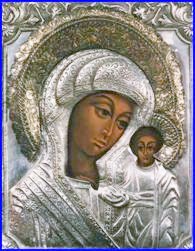
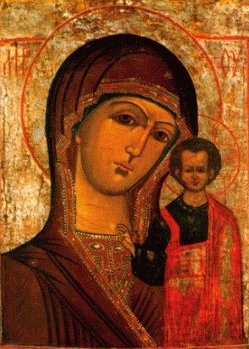
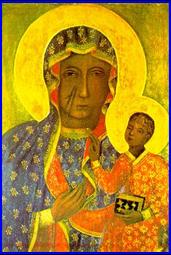
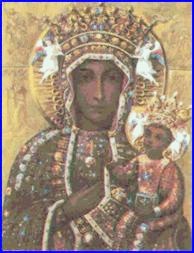


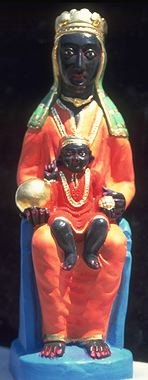
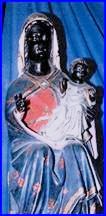
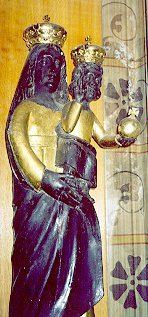
 In 1836, a man named Godfrey Higgins wrote a book called Anacalypsis, and in that book he identified all these European churches that had these images of a Black Madonna and Black Child. They were prevalent all over the place and it was not until much later that these images were replaced by images of Mary as white and Jesus as white.
In 1836, a man named Godfrey Higgins wrote a book called Anacalypsis, and in that book he identified all these European churches that had these images of a Black Madonna and Black Child. They were prevalent all over the place and it was not until much later that these images were replaced by images of Mary as white and Jesus as white.
Then there was a book that has been done by Ean Begg on the right, called the cult of the Black Virgins which is the best single source on the history of all these Black Madonnas. If more detail is needed on this subject, this is one of the sources that has tremendous bibliography attached to it that would clarify the evolution of the idea of a virgin first as Black as an imitation of Isis, and then later with the help of people like Michelangelo and others that you see here of the Madonna and Child idea, but this time she looks like an Italian.
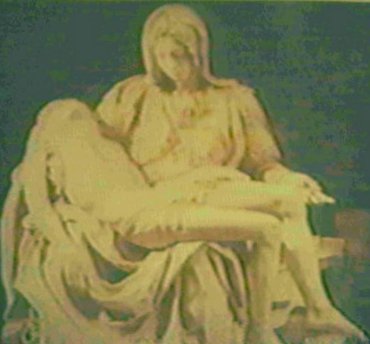
Remember that Pope Julius at one point made Michelangelo get up on his back in the sistine chapel and told him to paint some images and don't come down until you get some images that we can identify with.
So Michelangelo began to develop Italian images that they could identify with.
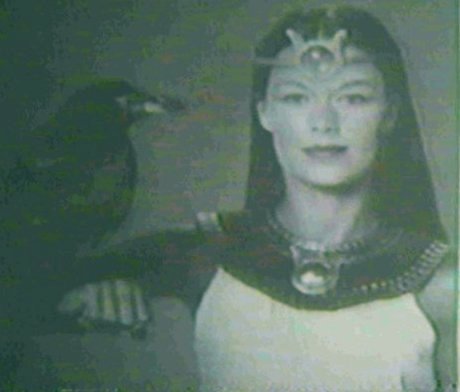 This image shows the evolution of Isis who is no longer Black in America and Horus her son who is no longer a Falcon but a Crow. So the original meaning of Isis is either lost or has become some big joke. This is the television Isis who is now shown as a white woman, but no where in the models of Isis that you saw in Egypt did you ever see her looking like this until the Greco-Roman period.
This image shows the evolution of Isis who is no longer Black in America and Horus her son who is no longer a Falcon but a Crow. So the original meaning of Isis is either lost or has become some big joke. This is the television Isis who is now shown as a white woman, but no where in the models of Isis that you saw in Egypt did you ever see her looking like this until the Greco-Roman period.
Remember Isis was the virgin mother of Horus. Sometimes Horus is shown as a little boy or little person and sometimes he is shown as a Falcon, but in this picture, you see that he is not a falcon but a crow, and you donít see Osiris at all.
This is a very important picture here. Where this comes from, you cannot take a good picture of this in the temple of Luxor where it appears.
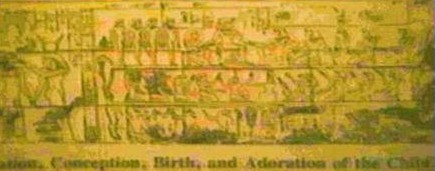
So you have the annunciation, and you have the virgin birth, then as you move on over in the scene, you have the adoration. You have all the wise people coming around to do homage to this new king. In other words, the story of a virgin birth, a young saviour, the announcement ahead of time by the angel of the Lord, the wise people coming around to adore - the adoration; all of that material already appears in the temple of Luxor in the 18th dynasty.
This is over a thousand years before the birth of Christ that this story appears in detail and it does not only appear in the temple of Luxor, it also appears in some other temples that were shown earlier with pictures of the Immaculate Conception. So here is the root of some ideas that you will see appear later on in the Christian religion that already were there in Egyptian religion.
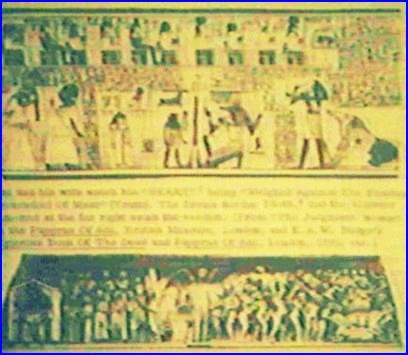 This next picture will show you, if you can see the bottom section, the weighing of the heart on one of the murals in the Christian religion. So here it is in Egypt and there it is imitated in the Christian religions.
This next picture will show you, if you can see the bottom section, the weighing of the heart on one of the murals in the Christian religion. So here it is in Egypt and there it is imitated in the Christian religions.
What is being pointed out is that our religion has always been more important to us than anything else, and when we find that the ideas that were expressed in religion in ancient times in Africa reappear later in Hebrew times, in Christian times and in Islamic times, then it is a testimonial to the power of those ideas to influence populations in other parts of the world.
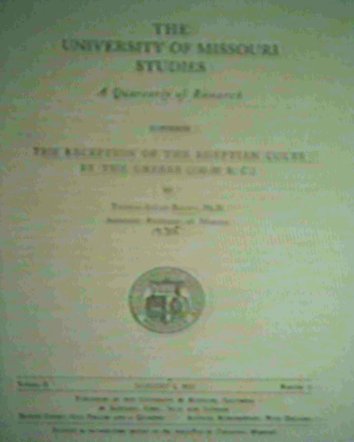
There is a nice publication that has been done at the University of Missouri called "The Reception of Egyptian Cults by the Greeks" written in 1935.
There is also another book not shown here and done by Harvard University Press called "Isis Among the Greeks and Romans," which shows that there is a lot of scholarly work that has been done on the connection between the religion of Isis and the development of the religion of Christianity.
 This is a map in one of the books that shows the spread from Egypt, those Black lands, all the way up into Asia Minor and to Thessalonia, Greece and so forth, and there were literally hundreds of churches that worshipped this Black Virgin from Africa. This was the religion that was in place at the time of the birth of Christ, and one of the competing religions with the Christian faith. It was one of the religions that was stamped out afterwards following the formal establishment of the Christian faith by the bishops from Rome. The last site being stamped out in 591 AD, so it was men that fought to give Christianity pre-eminence.
This is a map in one of the books that shows the spread from Egypt, those Black lands, all the way up into Asia Minor and to Thessalonia, Greece and so forth, and there were literally hundreds of churches that worshipped this Black Virgin from Africa. This was the religion that was in place at the time of the birth of Christ, and one of the competing religions with the Christian faith. It was one of the religions that was stamped out afterwards following the formal establishment of the Christian faith by the bishops from Rome. The last site being stamped out in 591 AD, so it was men that fought to give Christianity pre-eminence.
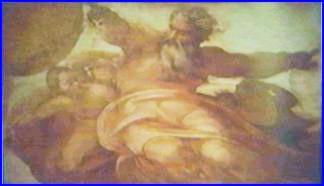 This is another example of Michelangelo's work, and its part of the sistine chapel painting where you now notice that God is looking different from how he was looking in Egypt. When Egyptians portrayed God, he was portrayed to look like themselves. Remember the images of Osiris, Ptah, and Amon? Those images were quite distinctly different from the ones that we see now. We probably ought not to have any images of God because we don't know what God looks like, so to pretend that we do simply sets up certain kinds of problems. But it sets up real problems for Black people to sit down every Sunday morning to look into the face of God, and that God is simply another human being who especially is not a person of their particular racial group. It sets up all sorts of confusion and no healthy people would do that, but there a lot of people who in ignorance continue to utilize images of their deity where the deity is not like themselves.
This is another example of Michelangelo's work, and its part of the sistine chapel painting where you now notice that God is looking different from how he was looking in Egypt. When Egyptians portrayed God, he was portrayed to look like themselves. Remember the images of Osiris, Ptah, and Amon? Those images were quite distinctly different from the ones that we see now. We probably ought not to have any images of God because we don't know what God looks like, so to pretend that we do simply sets up certain kinds of problems. But it sets up real problems for Black people to sit down every Sunday morning to look into the face of God, and that God is simply another human being who especially is not a person of their particular racial group. It sets up all sorts of confusion and no healthy people would do that, but there a lot of people who in ignorance continue to utilize images of their deity where the deity is not like themselves.

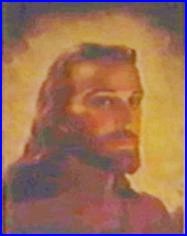 Some time ago Newsweek Magazine did a story on the images of Christ called Searching for the Real Jesus, and they had a lot of pictures in that particular issue of Newsweek Magazine.
Some time ago Newsweek Magazine did a story on the images of Christ called Searching for the Real Jesus, and they had a lot of pictures in that particular issue of Newsweek Magazine.
Some of the pictures looked like this one on the right which is like the image that most people had on their fans, and grew up thinking; oh that's what Christ must have looked like. But you don't stop to ask the question, who painted this picture and when did they paint it?
Now that doesn't look like any of the pictures that were painted of Christ in the early days. Now remember, no one has a picture of Christ that was painted at the time of Christ, and so it would be almost 200-300 hundred years later, after Christ is dead, before someone would come up with an image that still survives, but it didn't look like that one. So you ask yourself, who is the person that authorized this painting of Christ, especially when we can look at the oldest picture of Christ.
Below on the left is a picture of the fan with Jesus' picture on it which is found in many churches right now, where everybody sits down on Sunday mornings believing, in many cases, that it is the image of Christ.
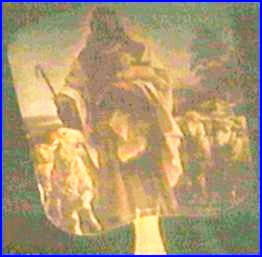
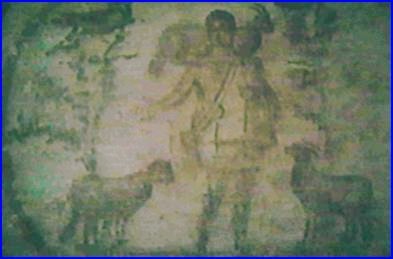
If we were to take the oldest picture of Christ found in the catacombs in Rome as shown on the right above, which goes back to the 4th century AD and take a very close look, you will see that Christ here, according to the early Christians in the catacombs, is a Black Person with Nappy hair. The question is, how did he get from the one on the right to the one on the left, or to the Newsweek version further above? When was the meeting held to decide to change the way Christians were to visualize Christ?
No one knows for sure who drew these pictures which may not necessarily represent how he actually looked, yet we fan ourselves into ignorance every Sunday morning as we look at the picture on the back of our fan or on the almanacs, believing it to be Christ when in fact it is not.
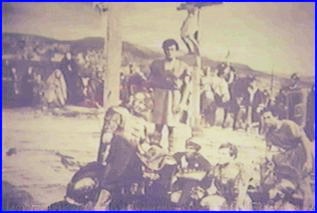 Here is what Hollywood now does to Christ, to Moses and to the figures that appear in the Bible. Remember you saw the pictures of Christ, of the Egyptians, Isaiah and so forth, but now when you look at the biblical times when Hollywood finally portrays them through Metro Goldwyn Meyer and so forth, look at who they choose to play the parts of these biblical figures; Victor Mature, Charlton Heston, Elizabeth Taylor. So here is the source of misinformation about what people looked like. Either we have to say that we know what they looked like from some kind of physical evidence, or we would have to say we don't know what they looked like. In that case, it is wrong to portray in any particular ethnic terms the historical figures of the Bible if we really don't know what they looked like.
Here is what Hollywood now does to Christ, to Moses and to the figures that appear in the Bible. Remember you saw the pictures of Christ, of the Egyptians, Isaiah and so forth, but now when you look at the biblical times when Hollywood finally portrays them through Metro Goldwyn Meyer and so forth, look at who they choose to play the parts of these biblical figures; Victor Mature, Charlton Heston, Elizabeth Taylor. So here is the source of misinformation about what people looked like. Either we have to say that we know what they looked like from some kind of physical evidence, or we would have to say we don't know what they looked like. In that case, it is wrong to portray in any particular ethnic terms the historical figures of the Bible if we really don't know what they looked like.

 |
 |
 |
 |
 |


